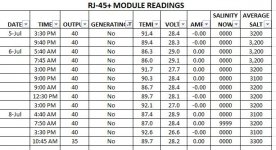Below is an update on my module numbers from the past 6 days so you can compare to your RJ-Series modules.
NOTE - Output was 40% until Sunday (10 Jul) where I was able to lower it a bit due to better FC production. CYA at 70-80. K-1766 showed 3,600 - 4,000.
Manual says: NOT GENERATING: 16-31 volts; amps will be zero
 Manual says: GENERATING: 21.0 to 27.0 volts; 2.50 - 7.80 amps
Manual says: GENERATING: 21.0 to 27.0 volts; 2.50 - 7.80 amps

What I learned:
- Amps appeared to be right in the middle of ideal range for both polarities.
- Volts was always on the low end when generating. Seemed to be no correlation to temp, salt, etc. Perhaps just the way the voltage is dispersed/recorded within the unit while generating?
- Advertised 2 lbs per day may be a bit optimistic with a brand new unit under ideal conditions. As we say here at TFP, always best to oversize your unit.
- It is critical that the water be as organic-free as possible. Any organic load could interference with cell efficiency and potentially lessen your FC production, even if you pass an OCLT (I did twice).
- My cell began to show improvement 9-10 July, allowing me to lower the output a little. I may try one more overnight GAIN test later to compare to my previous ones.
- I wish I would've taken note of these numbers when the unit was new in Apr 2020, but I'll refer back at these from time to time in the future.
- While you can attempt an overnight GAIN test using the
PoolMath APP to estimate FC gains at night, results can vary widely. My 7-hr @ 100% gains varied from 1.0 - 2.5 (projected 3.9)
- Would like my K-1766 readings to be closer to the module's salinity Now and Average Salt readings. Not sure if that disparity could be effecting the readings.
- If your cell has no error codes or red lights, you see bubbles, and is producing free chlorine, it is considered operating properly.
- If you attempt a warranty return, Discount Salt Pools will ask you about your chemistry to include phosphates and nitrates. They do not get into all the technic or production criteria we are discussing here. If you send the unit it for service and they determine the unit is operating as advertised, you may be held liable for any diagnostic service charges.





